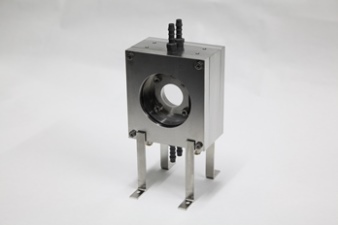Variable focus lens with a large optical aperture
Summary
In order to change focus with traditional solid lenses, which have fixed optical properties, two or more lenses have to be jointly moved mechanically. In contrast, a variable focus lens can dynamically control its focal length by only using a single lens element. Liquid-filled variable focus lenses are based on the physical deformation of refractive surfaces, which changes their curvature. Examples include liquid-air lenses, which are highly responsive and have excellent optical performance. However, if this kind of lens is placed vertically and its aperture is large, the lens profile might be asymmetrically deformed due to gravity. On the other hand, the liquid?liquid interface formed by two immiscible liquids can act as a refractive surface, the shape of which can be controlled by fluid pressure, electro-wetting, or dielectrophoretic effect.
Nevertheless, in order to maintain high optical performance, the size of the aperture should be small compared to the capillary length, due to physical limitations. Hence the size of the apertures of liquid-liquid lenses is always in the order of millimeters, and a liquid-infused lens with a large optical aperture is still an unsolved problem.
We proposed a novel variable focus lens with a large optical aperture. The lens consists of two chambers separated by a membrane. The chambers were infused with two different liquids characterized by their similar density but different refractive indices. The membrane was prepared by applying a homogeneous in-plane pretension force. The membrane was stretched over a circular hole in the wall that separates the two chambers, effectively making it subject to a circular boundary condition. Thus its deformation was in the interface between the two liquids, and it acted as a refractive surface due to the difference in refractive index of these liquids. If one fluid was made to flow into and out of its chamber, while the other was locked, the lens could shift its power dynamically by means of a syringe pump.
Based on the above concept a prototype of the variable focus lens with a 26 mm aperture was produced. Note however that pursuing larger apertures does not create additional technical challenges. The range of available focal lengths was experimentally verified to be in the range [-150 150] mm, with a minimal of F/5.

|

|
| Figure 1. A cross-sectional view of the lens system. | Figure 2. A photograph of the lens prototype. |
|---|
Movies
If you want to use the original video, please send an e-mail for copyright permission to contact .
References
- Lihui Wang, Hiromasa Oku, Masatoshi Ishikawa, An improved low-optical-power variable focus lens with a large aperture, Optics Express, Vol.22, Issue 16, pp. 19448-19456 (2014)[PDF(2.2M)][DOI:10.1364/OE.22.019448]
- Also selected for the Virtual Journal for Biomedical Optics, Vol.9, Issue 10 (2014)
- Lihui Wang, Hiromasa Oku, Masatoshi Ishikawa, Variable-focus lens with 30 mm optical aperture based on liquid--membrane--liquid structure, Applied Physics Letters, Vol.102, 131111 (2013)[PDF(1.1M)][DOI:10.1063/1.4800603]*AIP
- Lihui Wang, Hiromasa Oku, Masatoshi Ishikawa, A Weak Power Enhanced Liquid-Membrane-Liquid Lens by a Pretension Elastic Membrane, OSA's 97th annual meeting, Frontiers in Optics 2013/ Laser Science XXIX(FiO/LS 2013)(Orlando, Florida, USA, 2013.10.06-10)/ (Oral Session) [OSA Technical Digest FTu5F.5][DOI:10.1364/FIO.2013.FTu5F.5]
- Lihui Wang, Hiromasa Oku, Masatoshi Ishikawa, A solution of pre-tension membrane for improving the usability of liquid-membrane-liquid lens in its weak power area, 2nd EOS Conference on Optofluidics 2013 (Munich, Germany, 2013.05.13-15) / (Oral Session) [Abstract 1569716891]
- Lihui Wang, Hiromasa Oku, Masatoshi Ishikawa, Development of variable-focal lens with liquid-membrane-liquid structure and 30mm optical aperture, SPIE Photonics West 2013 (San Francisco, California, USA, 2013.02.02-07) / (Oral Session) [SPIE Proceedings 8617-5] [DOI:10.1117/12.2005531]
- Lihui Wang, Hiromasa Oku, Masatoshi Ishikawa, A Liquid Lens with Liquid-Membrane-Liquid Structure, OSA's 96th annual meeting, Frontiers in Optics 2012/ Laser Science XXVIII(FiO/LS 2012)(Rochester, NewYork, USA, 2012.10.14-18)/ (Oral Session)[OSA Technical Digest FM3A.3][DOI:10.1364/FIO.2012.FM3A.3]
*AIP © 2013 American Institute of Physics. This article may be downloaded for personal use only. Any other use requires prior permission of the author and the American Institute of Physics. The article appeared in L. Wang et al.,Appl. Phys. Lett. 102, 131111 (2013) and may be found at http://link.aip.org/link/?APL/102/131111.



